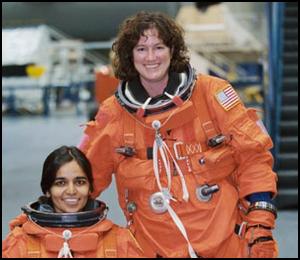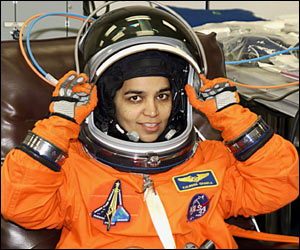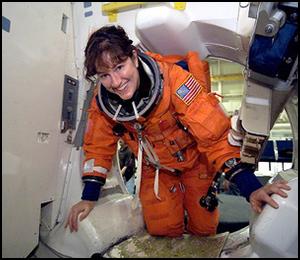Columbia
February 1, 2003
"They go in peace for all mankind... and all mankind is in their debt."
-President George W. Bush



An amateur photographer took this photo as shuttle debris streaked over Texas.
patch courtesy of NASA
![]()
On February 1, 2003, the shuttle Columbia was returning from 16 days in space when it broke apart over the southern United States, shedding debris across thousands of square miles. All seven astronauts aboard the shuttle were killed in the accident.\
THE WOMEN OF COLUMBIA: Kalpana Chawla and Laurel Clark

http://spaceflight.nasa.gov/gallery/images/shuttle/sts-107/html/jsc2001-02458.html
KALPANA CHAWLA:

photo courtesy NASA
Kalpana Chawla (or K.C., as her friends called her) was born in Karnal, India. Said President Bush, "None of our astronauts traveled a longer path to space than Kalpana Chawla."
K.C. decided to be an aerospace engineer at an early age. She was inspired by airplanes, and convinced her father to get her rides from the local flying club. After graduating from high school K.C. earned her bachelor of science in Aerospace Engineering from Punjab Engineering College, India, in 1982. She moved to the United States to get her master's degree from the University of Texas-Arlington in 1984 and her doctorate from the University of Colorado, Boulder in 1988.
Kalpana began working for NASA at the Ames Research Laboratory, where she studied complex fluid dynamics such as the airflows around Harrier jets. She became an astronaut in 1995.
K.C. loved flying small planes and was a certified flight instructor for both planes and gliders. She also held a commercial pilot's license for single- and multi-engine land and sea planes and an instrument rating for airplanes. She especially loved to go flying with her husband. Kalpana also enjoyed hiking and backpacking.
LAUREL CLARK:

http://spaceflight.nasa.gov/gallery/images/shuttle/sts-107/html/jsc2002e15463.html
Laurel Clark was born on March 10, 1961, in Ames, Iowa. As a child she was fascinated with animals and the environment. "I was interested in the Moon landings just about the same as everyone else of my generation," Laurel said, "but I never really thought about being an astronaut or working in space myself."
Laurel graduated from high school in 1979, then spent eight years at the University of Wisconsin, Madison, where she earned an undergraduate degree in zoology and a doctorate in medicine. Her work after college included the US Navy, where she worked as an undersea medical officer, diving with teams and performing medical evacuations from submarines.
Clark said that her time in the Navy exposed her to many different work environment, ranging to submarines and working in close quarters with many other people, and that working as an astronaut seemed to follow naturally from her position in the Navy. "I thought about the things I had done so far and became more interested in [being an astronaut] as a career."
Her sixteen-day flight on Columbia was her first.
![]()
For more information on the Columbia Tragedy, the following sites are very useful:
NASA Columbia Homepage (The interactive memorial to the crew is a particularly nice link):
http://www.nasa.gov/columbia/home/index.html
CNN.com: Includes video simulations of the accident and its causes, as well as crew bios, timelines, and much more:
http://www.cnn.com/2003/TECH/space/02/01/shuttle.columbia/